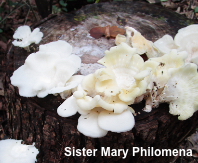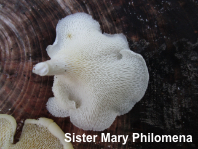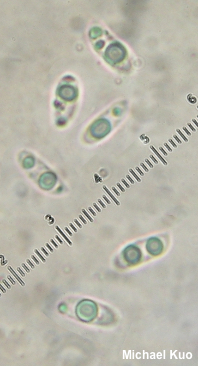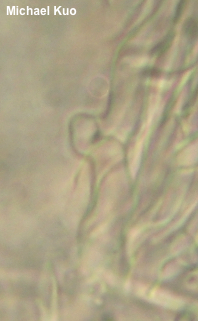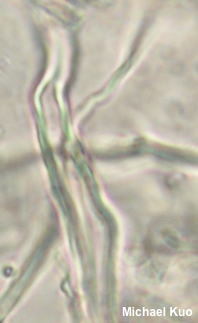| Major Groups > Polypores > Stemmed, Pale-Fleshed > Favolus brasiliensis |

|
[ Basidiomycota > Polyporales > Polyporaceae > Favolus . . . ] Favolus brasiliensis by Michael Kuo, 25 October 2022 This tropical polypore appears on the deadwood of hardwoods in the Americas from South America to Central America and the Caribbean—and in North America from Mexico through Texas, along the Gulf Coast, and into Florida. It has a distinctive pore surface composed of large, hexagonal, elongated pores, and a white to pale yellowish cap that becomes radially ridged or lined with age. Field guides often call this fungus "Polyporus tenuiculus" or "Favolus tenuiculus," but research over the past decade or so indicates that the best name for the tropical American species is Favolus brasiliensis—Favolus because its DNA (based on LSU and ITS sequences) separates it from the core of Polyporus species, and brasiliensis because that name represents a species from the Americas, while tenuiculus represents a species described from western Africa for which the type collection "seems to be inaccessible" (Sotome et al. 2013; ask me whether that vagueness would have survived peer review had I been the peer, lol), making the name ambiguous. There may be at least two phylogenetic species hanging out within Favolus brasiliensis (Palacio et al. 2021); additional sampling and research will be required before species lines can be drawn more clearly. Thanks to Sister Mary Philomena, O. P., for documenting, collecting, and preserving Favolus brasiliensis for study; her collection is deposited in The Herbarium of Michael Kuo. Description: Ecology: Saprobic on the deadwood of various hardwoods; causing a white rot; growing alone, gregariously, or in overlapping clusters; found year-round; originally described from Cuba (Fries 1821); distributed throughout the tropics in North America, Central America, and South America; also found in the Caribbean. The illustrated and described collection is from Texas. Cap: 1.5–6.5 cm across; semicircular to round or lobed in outline; planoconvex becoming shallowly vase-shaped; thin; dry; finely fuzzy or nearly bald; white to pale yellowish; radially wrinkled or lined at maturity. Pore Surface: Running down the stem; pores elongated and hexagonal, up to 5 mm long and 1 mm wide; white to pale yellowish; not bruising. Stem: Usually lateral or off-center; 1–2 cm long; up to 5 mm thick; tough; white. Flesh: White; unchanging when sliced. Odor and Taste: Odor slightly foul, especially in rehydrated material; taste not distinctive. Spore Print: White. Microscopic Features: Spores 7–11 x 3–4 µm; elongated-ellipsoid or subcylindric; smooth; hyaline and uni-, bi-, or multiguttulate in KOH; inamyloid. Basidia 24–28 x 4–5 µm; 4-sterigmate. Cystidia not found. Setae not found. Hyphal system dimitic: generative hyphae 3–5 µm wide, thin-walled, smooth, clamped at septa; skeletal hyphae 4–8 µm wide, thick-walled; smooth; aseptate. REFERENCES: (E. M. Fries, 1821) E. M. Fries, 1828. ( Overholts, 1953; Gilbertson & Ryvarden, 1987; Bessette et al., 1995; Ryvarden, 1999; Ryvarden & Iturriaga, 2003; Sotome et al., 2008; Sotome et al., 2013; Zhou & Cui, 2017; Elliott & Stephenson, 2018; Palacio et al., 2019; Palacio et al., 2021; Ji et al., 2022.) Herb. Kuo 09112203. This site contains no information about the edibility or toxicity of mushrooms. |
© MushroomExpert.Com |
|
Cite this page as: Kuo, M. (2022, October). Favolus brasiliensis. Retrieved from the MushroomExpert.Com Web site: http://www.mushroomexpert.com/favolus_brasiliensis.html |
